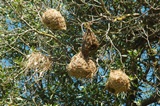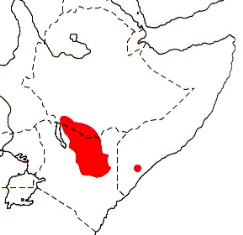Weaver species
Choose different species from drop-down list and press 'Go' button. See Full species list.Donaldson-Smith's Sparrow-Weaver Plocepasser donaldsoni
IUCN: Least concern Discovery: 097Categories: Plocepasser, cooperative,
News items about species
Discovery
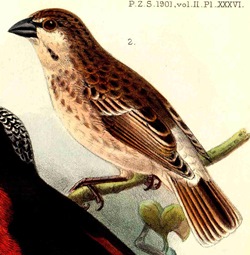
adult, figure from Sharpe (1901) 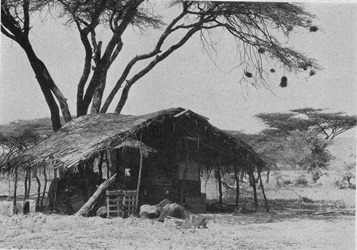
nests, figure from Oberholser (1945) 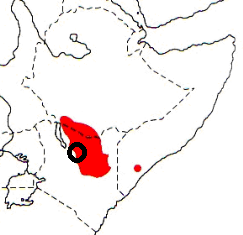
distribution, type locality circled 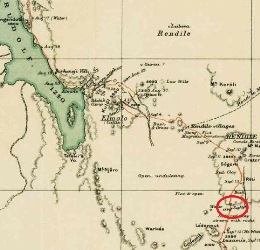
type locality circled IntroductionDonaldson-Smith's Sparrow-Weaver was formally described by Richard Bowdler Sharpe, an English zoologist.Donaldson-Smith's Sparrow-Weaver was collected by Arthur Donaldson Smith, an American doctor, amateur big-game hunter, and explorer of Africa. In in 1894-95 Donaldson Smith undertook an 18-month geological expedition in East Africa. The expedition started in Berbera, Somalia (then British Somaliland), passed through what was then Somaliland, southern Ethiopia and then to Lake Rudolph (now Lake Turkana) in Kenya. Donaldson Smith collected birds and many animals, particularly fish, spiders, scorpions, butterflies and beetles. The expedition left Lake Rudolf on 24 August 1895, and went SW, and crossed Marsabit Mt. On 13 September Donaldson Smith had a close encounter with an elephant, and the next day he collected the weaver specimen. He reached Lasamis on 16 September. Donaldson Smith wrote a book about his travels, which can be downloaded here (295 Mb). The first illustration of the Donaldson-Smith's Sparrow-Weaver was of an adult, published by Sharpe (1901). The next illustration was a black and white photo of nests by Oberholser (1945). Scientific citationPlocepasser donaldsoni Sharpe 1895a, Bull. Br. Orn. Club, 5, p.14 'Eastern Africa' = Lasamis, Kenya.Meaning of namesdonaldsoni, Named after A. Donaldson-Smith (1864-1939) US zoologist and collector in Somaliland, 1894-1895.First English nameDonaldson Sparrow-Weaver (Shelley 1905b).Alternate namesDonaldson's Sparrow-Weaver, Somali Grey Sparrow Weaver.CollectorArthur Donaldson Smith.Date collected14 Sep 1895.Locality collectedLasamis, Kenya.Type specimensThe type is in the British Museum (BM 1895.7.7.23). |
The above is based on Weaver Wednesday 2, a weekly series about the discovery of each weaver species.
This species text first appeared as
Weaver Wednesday [214] - Discovery [97]: Donaldson-Smith's Sparrow-Weaver on 2016-07-20
1. Basic biology
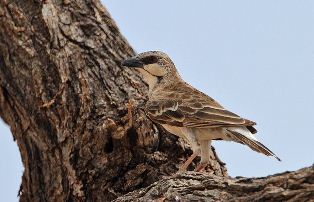
figure from wikipedia Distribution.
Donaldson-Smith's Sparrow-Weaver is found in southern Ethiopia (eg. Mago National Park, but rare in Omo National Park) and in northern Kenya (particularly in the Isiolo district game reserves). In Somalia, it has only been recorded at Afmadow (see map below, based on Birds of Africa). It is a common but very local bird. No subspecies of the Donaldson-Smith's Sparrow-Weaver have been proposed.
Donaldson-Smith's Sparrow-Weaver is poorly-known. Its call has been recorded - see here. Habitat. Donaldson-Smith's Sparrow-Weaver inhabits dry bushland, open woodland, grassland and rocky areas; and even in barren lava country in north Kenya. Food. Donaldson-Smith's Sparrow-Weaver forages on the ground, feeding on grass seeds and insects. It occurs in small flocks, which may associate with the White-headed Buffalo-Weaver. Breeding. Donaldson-Smith's Sparrow-Weaver is colonial. Its mating system is unknown but it is probably a co-operative breeder, like other sparrow-weavers. The nest is a mass of grass with a short entrance tube, lined with feathers; it resembles the nests of other sparrow-weavers, but is larger than that of the White-browed Sparrow-Weaver. The nest is placed in low thorn trees 1.5-3m above the ground, or in stunted bushes. A colony of 20 nests in a single bush has been recorded. The eggs are pinkish or greyish, with fine speckles of mauve and reddish-brown, but clutch size has not been recorded.
|
The above is based on Weaver Wednesday, a weekly series about weaver species.
This species text first appeared as
Weaver Wednesday [37]: Donaldson-Smith's Sparrow-Weaver on 2013-02-27
2. Breeding facts
| Pair bond No information; probably a co-operative breeder Breeding season Breeds in Jan, Jun, Jul, Sept and Dec in Kenya Nest site placed 1.5-3 m above ground in low thorn tree or bush Nest building n/a Colony size up to 20 nests in single tree Clutch size not recorded Egg colour eggs pinkish or greyish, with fine, diffuse speckles of mauve and reddish-brown Egg size No information Incubation No information Chicks and nestling period No information |
Breeding information based on Handbook of the Birds of the World, Vol. 15.
3. Photos of Weaver Nests
 Vm 24562 |  Vm 9254 |  Vm 3221 |  Vm 2646 |
Thumb-nails of most recent PHOWN records - click on one to see its full record
See all PHOWN records for this species here.
PHOWN (Photos of Weaver Nests) provides valuable info on breeding distribution and colony sizes of weavers.
You can contribute by registering and submitting photos at Virtual Museum webpage.
4. Breeding distribution
Google map showing distribution (For species with small ranges you need to zoom in at the correct area to see the range):
yellow blob - range of weaver species; read more about this here.
![]() - PHOWN records with photos
- PHOWN records with photos
![]() - PHOWN records with no photos (Nest Record Cards, other records)
- PHOWN records with no photos (Nest Record Cards, other records)
![]() - Birdpix records
- Birdpix records
![]() - comments on out of range records, or interesting records
- comments on out of range records, or interesting records
![]() - type locality
- type locality
CLICK on the marker on the map to see individual record details.
5. Range changes
Not South African speciesThe above is based on Weaver Wednesday 3, a weekly series about range changes in South African weaver species.
This species text first appeared as
n/a








